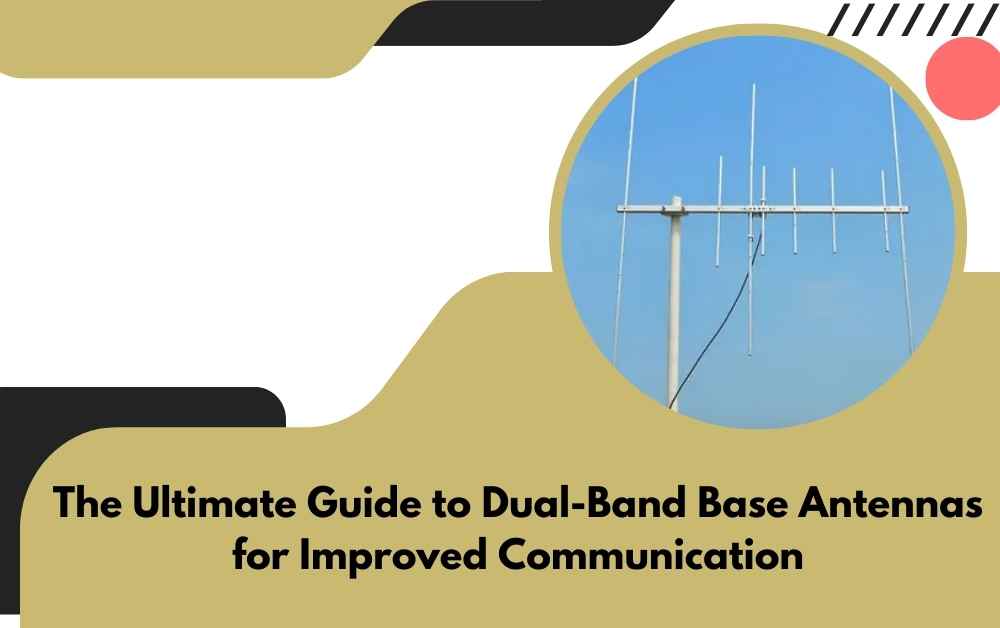Communication is the cornerstone of our modern world, connecting people and facilitating information exchange. Whether it’s for emergency services, amateur radio, or just staying in touch with loved ones, having a reliable antenna is crucial. In this guide, we’ll explore the world of dual band base antennas. Don’t worry if you’re not a tech whiz; we’ll break it down in simple terms to help you understand everything you need to know about these antennas.
What are Dual-Band Base Antennas?
Let’s start at the beginning: What exactly are dual-band base antennas? Well, they are specialized tools designed to enhance communication over a range of frequencies. These antennas are incredibly versatile and can be used for a variety of purposes, including ham radio, public safety, and even regular home use.
Key Points:
- Dual-band base antennas enhance communication over a range of frequencies.
- They are versatile and have various applications, including ham radio and public safety.
How Do Dual-Band Base Antennas Work?
Now, let’s delve into the workings of dual-band base antennas without getting too technical. Think of these antennas as the ears and mouth of your communication system. They receive signals from the surrounding area and transmit your messages to others. Dual-band antennas excel at this because they’re designed to work on two different frequency bands, often the VHF (Very High Frequency) and UHF (Ultra High Frequency) bands.
Key Points:
- Dual-band base antennas receive and transmit signals.
- They work on two different frequency bands, typically VHF and UHF.
Advantages of Dual-Band Base Antennas
So, why should you consider using dual-band base antennas? Let’s explore some of their advantages in everyday language:
1. Better Coverage
Imagine you’re on a road trip. Sometimes you’re driving on the highway (UHF), and other times you’re navigating through rural areas (VHF). Dual-band antennas ensure you have good signal coverage, no matter where you are. They adapt to different terrains and situations, just like a versatile GPS system.
2. Space-Saving
Most of us prefer having extra storage space in our homes. Dual-band antennas are a space-saving solution. Instead of having two separate antennas for VHF and UHF, you can use one dual-band antenna to cover both frequency ranges. This means less clutter on your roof or in your attic.
3. Cost-Effective
Buying two separate antennas can be costly, not to mention the installation and maintenance expenses. Dual-band base antennas save you money in the long run. You purchase and install one antenna, and it efficiently covers both frequency bands.
4. Easy to Install
You don’t need to be a tech genius to set up a dual-band base antenna. Many models come with user-friendly instructions, and you can find plenty of online resources and tutorials to help you along the way. It’s like assembling a piece of furniture with clear instructions – no need to hire a professional.
Common Applications
Dual-band base antennas have a wide range of applications that can benefit both individuals and communities. Here are some common uses:
1. Ham Radio Enthusiasts
If you’re into ham radio, dual-band antennas are a must-have. They allow you to communicate effectively across different frequencies, making it easier to connect with fellow ham radio operators.
2. Emergency Services
First responders and public safety agencies often rely on dual-band antennas. These antennas provide reliable communication during critical situations, ensuring that help arrives quickly and efficiently.
3. Home Communication
Want to stay in touch with family and friends who live far away? Dual-band base antennas can improve your communication quality, whether you’re using walkie-talkies or other radio devices.
Choosing the Right Dual-Band Base Antenna
Now that you understand the benefits and applications, let’s talk about choosing the right dual-band base antenna for your needs. Here are some factors to consider:
1. Frequency Range
Different dual-band antennas cover different frequency ranges. Ensure that the antenna you choose aligns with the frequencies you plan to use. This information is usually provided in the antenna’s specifications. Dual-band base antennas offer a simple yet effective solution for enhancing communication across various frequency ranges. They are versatile, cost-effective, and easy to install, making them a valuable addition to your communication setup, whether you’re a ham radio enthusiast, a first responder, or simply looking to improve your home communication.
2. Gain
Gain refers to the antenna’s ability to focus and amplify signals. Higher gain antennas can transmit and receive signals over longer distances. Consider the range you need and choose an antenna with an appropriate gain rating. Dual-band base antennas offer a simple yet effective solution for enhancing communication across various frequency ranges. They are versatile, cost-effective, and easy to install, making them a valuable addition to your communication setup, whether you’re a ham radio enthusiast, a first responder, or simply looking to improve your home communication.
3. Mounting Options
Dual-band antennas can be mounted in various ways – on a roof, in an attic, or on a pole. Check the mounting options available for the antenna you’re considering and ensure it’s suitable for your installation location. Dual-band base antennas offer a simple yet effective solution for enhancing communication across various frequency ranges. They are versatile, cost-effective, and easy to install, making them a valuable addition to your communication setup, whether you’re a ham radio enthusiast, a first responder, or simply looking to improve your home communication.
4. Build Quality
A durable antenna can withstand various weather conditions. Look for antennas made from high-quality materials like fiberglass or stainless steel, which are corrosion-resistant and built to last.
Installation and Maintenance
Installing a dual-band base antenna is a straightforward process, but it’s essential to follow the manufacturer’s instructions carefully. If you’re not confident in your DIY skills, consider hiring a professional to ensure proper installation.
Maintenance is generally minimal, but it’s a good idea to periodically inspect your antenna for any signs of wear or damage. Clean it as needed, and make sure all connections are secure to maintain optimal performance.
Conclusion
Dual-band base antennas offer a simple yet effective solution for enhancing communication across various frequency ranges. They are versatile, cost-effective, and easy to install, making them a valuable addition to your communication setup, whether you’re a ham radio enthusiast, a first responder, or simply looking to improve your home communication.
Remember to choose an antenna that suits your specific needs, and follow the manufacturer’s instructions for installation and maintenance. With the right dual-band base antenna, you’ll enjoy improved signal coverage and reliable communication, connecting you with the world around you.




